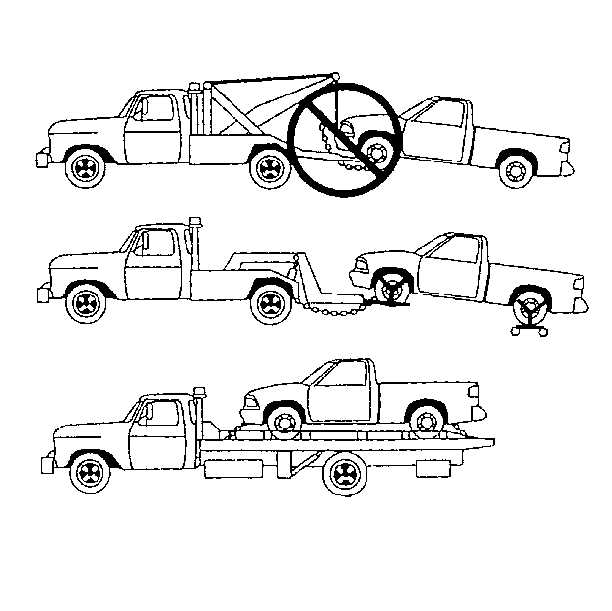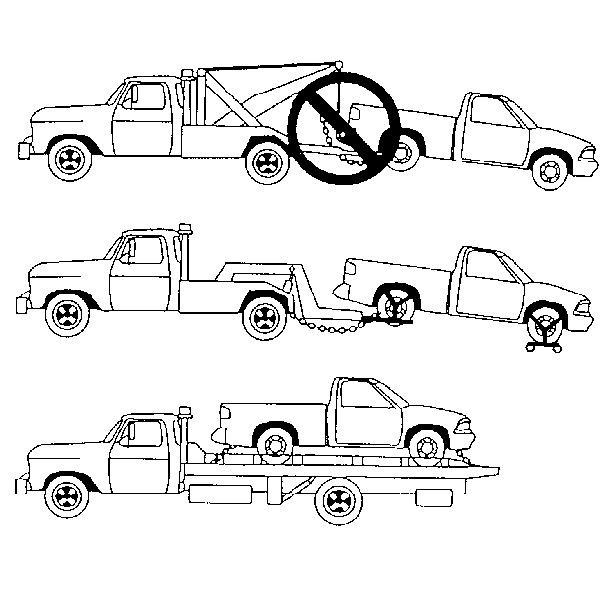Towing a Disabled Vehicle Platform Recommendations
Disabled Vehicle Towing General Information
In order to ensure the safest possible towing of disabled vehicles, General Motors has preferred equipment and methods that will minimize any possible vehicle damage when towing General Motors passenger cars and Light Duty trucks. This equipment and these methods are designed to take into account current trends in automotive aerodynamics and design flexibility. The following components are subject to possible damage if the vehicle is towed improperly:
| • | Drive systems such as four wheel drive and all-wheel drive with manual and electronic transfer cases |
| • | Lighter gage bumper systems |
| • | Aerodynamic spoilers and air-dams. |
| • | Exhaust system and other underbody components |
Platform Specific Disabled Vehicle Towing
Some of the equipment and procedures outlined below may not apply to the S/T Truck platform. Follow the specific towing procedures for the S/T Truck platform. Refer to Towing a Disabled Vehicle .
Sling-type Towing Equipment
Sling-type equipment may be used when towing certain General Motors passenger cars and Light Duty Trucks. Many of the newer GM vehicles, however, cannot be towed without damage using the sling-type equipment.
Wheel Lift and Car Carrier Equipment
Other methods have been developed in order to prevent damage to bumpers, air dams, and drive train components. The wheel lift equipment is designed to prevent either the front or rear wheels from turning while the vehicle is being towed. The car carrier is the safest method for towing a disabled vehicle. The vehicle is locked onto a platform on the back of the towing vehicle. All wheels are prevented from turning. Also, any damage caused by irregularities in the road surface is prevented.
Towing Dolly
A towing dolly can increase ground clearance when towing over rough or irregular surfaces. This will help to avoid damage to the exhaust system or front valances that could come into contact with the ground. A towing dolly can also increase the clearance between the wheel-lift and the underbody of the towed vehicle. With the towing dolly installed, raise the vehicle until there are adequate clearances between the wheel-lift equipment and the underbody of the towed vehicle.
Towing Over Rough Terrain
Care must be taken in order to assure adequate ground clearance when towing over rough terrain or when crossing sharp rises such as curbs. Curbs and other sharp rises should be crossed at an angle of approximately 45 degrees. This will allow one wheel of the tow truck to cross the curb at a time.This will minimize the chance of scraping or other damage to the vehicle being towed.
Stopping
"Panic" or "Spike" stops should be avoided. Damage to the vehicle being towed may result from fast stops.
Towing When the Keys Are Not Available
When the keys are not available, a towing dolly must be placed under the drive wheels and the opposite end of vehicle lifted.
Safety
Any loose or protruding parts of a damaged vehicle, such as hoods, doors, fenders, trim, must be secured prior to moving the vehicle. Also, NEVER allow anyone to ride in a vehicle being towed for any reason.
The safety of the operator and all others in the vicinity of the tow truck or the towed vehicle must be considered at all times during a towing operation. Safe operating speeds depend on weather, road, traffic, and visibility conditions. The condition of the towed vehicle must also be considered.
All state and local laws regarding such items as warning signals, night illumination, speed, etc., must be followed.
Caution: In order to avoid personal injury and/or property damage, observe the following
precautions:
• NEVER rock or pivot a disabled vehicle supported on jack stands, not even
to help place the towing dolly under the vehicle. • NEVER go underneath a vehicle while it is lifted by the towing equipment
unless it is also supported on jack stands. • NEVER tow a vehicle in excess of any safe speed or conditions, or the
applicable speed limit.
Caution: A vehicle can fall from a car carrier if it is not properly secured. This can
cause a collision, serious personal injury, and vehicle damage. In order to secure
the vehicle before towing, observe the following precautions:
• Use chains or steel cables. • Do not use substitutions such as ropes, leather straps, or canvas webbing,
which can be cut by sharp edges underneath the vehicle being towed. • Do not use "J" hooks.
Towing a Disabled Vehicle Platform Specifications
Reviewing General Disabled Vehicle Towing Procedures
In order to ensure the safest possible towing of disabled vehicles, review the General Disabled Vehicle Towing Procedures. Refer to Towing a Disabled Vehicle .

Front Towing Two Wheel Drive & Four Wheel Drive Vehicles
In order to tow the vehicle from the front end:
| • | Use wheel lift or car carrier equipment. |
| • | Additional ramping may be required for car carrier equipment. |
| • | Use safety chains and wheel straps. |
| • | Follow the appropriate transfer case procedures for four wheel drive vehicles (if equipped) outlined below. |
Notice: Do not tow the vehicle with sling-type equipment or damage to fascia/fog lamps will occur.
Towing a vehicle over rough surfaces could damage a vehicle. Damage can occur from vehicle to ground or vehicle to wheel-lift equipment. In order to help avoid damage, install a towing dolly. Raise the vehicle until adequate clearance is obtained between the ground and wheel-lift equipment.
Rear Towing Two Wheel Drive & Four Wheel Drive Vehicles
In order to tow the vehicle from the rear end:
| • | Use wheel lift or car carrier equipment. |
| • | Additional ramping may be required for car carrier equipment. |
| • | Use safety chains and wheel straps. |
| • | Follow the appropriate transfer case case procedures for four wheel drive vehicles (if equipped) outlined below. |
Notice: Do not tow the vehicle with sling-type equipment or damage to fascia/fog lamps will occur.
Towing a vehicle over rough surfaces could damage a vehicle. Damage can occur from vehicle to ground or vehicle to wheel-lift equipment. In order to help avoid damage, install a towing dolly. Raise the vehicle until adequate clearance is obtained between the ground and wheel-lift equipment.Towing Four Wheel Drive Vehicles (with Electric Shift Transfer Case)
In order to tow a four wheel drive vehicle with an electric shift transfer case, follow this procedure:
- Place transfer case in 2 Hi.
- Place transmission in Neutral (with automatic or manual transmission).
- Do not exceed 35 MPH.
- Maximum distance is 50 miles.
Towing All-Wheel Drive Vehicles
Notice: In order to help avoid property damage when towing an All-Wheel Drive vehicle,
a towing dolly must be placed under the wheels that would otherwise be on the ground.
• The steering wheel must be clamped in the straight-ahead position when
towing from the front or rear using a clamping device designed for towing service. • Do not use the vehicle's steering column lock. • A separate safety chain must be used on each side of the vehicle.

In order to tow an All-Wheel Drive vehicle from the front end:
| • | Use wheel lift with towing dolly or car carrier equipment. |
| • | Additional ramping may be required for car carrier equipment. |
| • | Use safety chains and wheel straps. |

In order to tow an All-Wheel Drive vehicle from the rear end:
| • | Use wheel lift with towing dolly or car carrier equipment. |
| • | Additional ramping may be required for car carrier equipment. |
| • | Use safety chains and wheel straps. |
